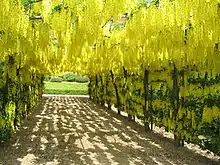| Laburnum × watereri | |
|---|---|
 | |
| The John Beer Laburnum Walk | |
| Scientific classification | |
| Kingdom: | Plantae |
| Clade: | Tracheophytes |
| Clade: | Angiosperms |
| Clade: | Eudicots |
| Clade: | Rosids |
| Order: | Fabales |
| Family: | Fabaceae |
| Subfamily: | Faboideae |
| Genus: | Laburnum |
| Species: | L. × watereri |
| Binomial name | |
| Laburnum × watereri | |
Laburnum × watereri (or Laburnum watereri), is a naturally occurring hybrid species of Laburnum, native to Central Europe. Its parents are common laburnum, Laburnum anagyroides, and alpine laburnum, Laburnum alpinum. A small deciduous tree or large shrub, it is a popular garden plant, called golden chain tree for its spectacular display of hanging clusters of yellow pea-like blossoms.[2] It can be trained to take forms such as arches and espaliers.
The best known cultivar is 'Vossii', which has gained the Royal Horticultural Society's Award of Garden Merit.[3] Growing eventually to 8 m (26 ft) tall and broad, it bears pendent 60 cm (24 in) racemes of bright yellow flowers in spring. It prefers a position in full sun.[3]
All parts of the plant are poisonous, although mortality is very rare.[4]
References
- ↑ Handb. Laubholzk. 3:673. 1893
- ↑ Dirr, Michael A. (2011). Dirr's Encyclopedia of Trees and Shrubs. Timber Press. p. 418. ISBN 9780881929010.
- 1 2 "Laburnum × watereri 'Vossii' Voss's laburnum". Retrieved 28 December 2019.
- ↑ Forrester R.M. (1979). "Have you Eaten Laburnum?". The Lancet. 313 (8125): 1073. doi:10.1016/S0140-6736(79)92963-5. PMID 86787. S2CID 38961471.